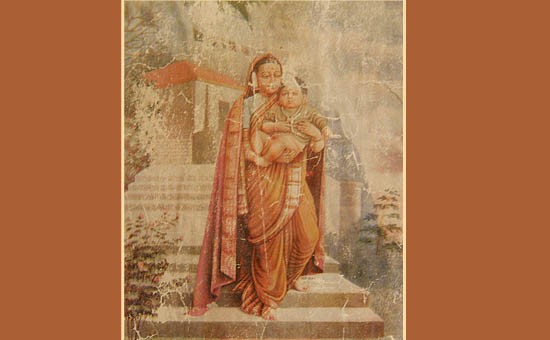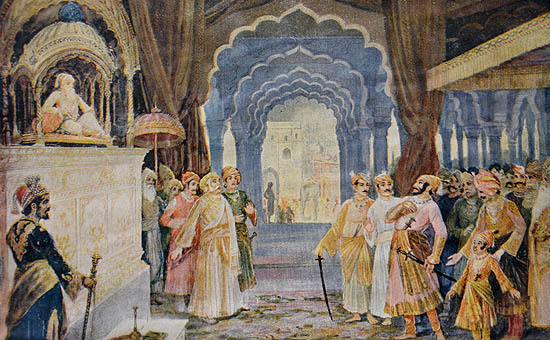-
On the occasion of Chhatrapati Shivaji Maharaj's birth date according to the Saka calendar we begin the narration of the stirring story of his life and achievements. This part tells us the story from his birth till the year 1666...when he returned from perhaps the biggest challenge of his life – the visit to Aurangzeb’s court at Agra.
The day Phalguna Vadya Tritiya of the Saka calender - adopted by the Indian state after 1947 – is the day when Shivajiraje was born on the fort of Shivneri near Junnar. His father Shahaji raje Bhonsle was then in the midst of war, trying to salvage the Nizamshahi kingdom from the attack by the Mughals and Bijapur. Pune, just south of Shivneri, was eventually granted as a jagir to Shahaji raje and it was here that Shivaji with his mother Jijau, grew to manhood. By all accounts, he grew up seeing the effects of war on his people, and as a child retained the vivid impression of war the province was subjected to. The quest to seek one’s own kingdom must have arisen in these early years and in 1647 just after the death of Dadaji Konddeo, who managed his estate with loyalty and care, he captured the forts of Torna and Kondhana near Pune. When the Bijapur sultan objected, he was told it was merely for the purpose of caretaking and there was no desire to oppose their rule.
It was not easy in this frontier state to
confront the growing Mughal power coming from the north and the Bijapur state
from the south. One finds the young Shivaji therefore carefully building his
strength before declaring his intentions. His taking of forts in the region was
resented by Bijapur and to force him to return these, his father was taken into
custody. Reluctantly, some of these possessions had to be returned, however,
the direction was clear.
 Shivaji as a baby
Shivaji as a baby
In 1656-57, events created a favourable situation in the Pune region. Muhammad Adil Shah of Bijapur died and his eighteen-year old son came to the throne. The Mughal Viceroy Aurangzeb left for the north to fight the battle of succession on hearing of Shah Jehan’s illness. The opportunity was not to be wasted. Rapidly, Shivajiraje took back the forts he had captured, crucially he took the thickly forested hilly region of Javli south of Pune and crossed the ghats into the Konkan where he conquered the towns of Kalyan and Bhiwandi. He also ordered his Peshwa to build the fort of Pratapgad.
The next year Shivajiraje began establishing
the Maratha navy to counter the Abyssinian Siddi of Janjira, who as a feudatory
of Bijapur, had oppressed the coastal population for long and had a strong navy
of his own. Using Portuguese artisans led by a father son duo named Viegas,
Shivaji built his first twenty ships at Kalyan before the Portuguese Viceroy
ordered his men to withdraw their help. However, the technique had been learnt!
The ship-building continued. Kalyan had an inland waterway and egress to the
sea that was controlled by Portuguese forts. Eventually, the Maratha fleet
found its way to the open sea and began to counter the Siddi. The Maratha Navy
was a visionary step and Sir Jadunath Sarkar has said, ‘Nothing proves
Shivaji’s genius as a born statesman more clearly than his creation of a Navy
and Naval bases’ – Sir Jadunath Sarkar
The court at Bijapur was smarting under the invasion of its territory and when Shahaji raje plainly told the court that his ‘son does not listen to him’, they decided to send a large army under their able commander Afzal Khan to capture or kill Shivaji. Afzal Khan had earlier been instrumental in the death of Shivaji’s elder brother Sambhaji and his feelings for the Bhonsle family were well known. Shivaji therefore prepared well. Afzal Khan with his large army came plundering the towns of Tuljapur and Pandharpur, damaging the temples there and hoping to draw Shivaji out of his mountain fastness. However, Shivaji retreated into the deep forests of Javli and took post atop Pratapgad. Afzal Khan was soon at Wai. Here, Shivaji sent his emissary who convinced the Khan to come to Javli with a small army as Shivaji was ‘scared’. The powerfully built Afzal Khan made the decision to leave the bulk of his army behind and proceed to Javli. His fate from then on was not in his hands.
At Pratapgad, Shivaji had arranged his army to trap the Bijapur force inside the Javli valley. All exits from the valley were guarded by the Mavla army and five separate commanders with a thousand men each were hidden all-round the proposed meeting place. Shivaji insisted the meeting would be with just one attendant. The tent was thus raised and seemingly hesitant, the Maratha raja descended the steps of the fort to approach his enemy. Afzal Khan, confident of his own powers, seems to have opened his arms to engulf the smaller frame of Shivajiraje with a dagger concealed in his right hand. Shivaji had prepared well with a steel helmet under his ‘pugdi’ and a tiger claw in his hand. Just as they met, the Khan is said to have tried to stab Shivaji in his back, while Shivaji struck with his tiger claws pulling out Afzal Khan’s innards. The Khan’s grip loosened and a duel ensued. Attendants rushed in and Jiva Mahala, a captain in Shivaji’s army fought valiantly for his king. The Khan was killed and his head taken away to the fort of Rajgad. The Bijapur army was attacked and routed. The reverse led to their loss of a string of forts all the way to Panhala.
The year 1659 therefore marked a change and
expansion of Shivaji’s kingdom to the sea and to the south. Bit by bit – like
the phases of the new moon – his kingdom grew for the welfare of his people.
The Bijapur challenge was quelled soon after as their siege at the fort of
Panhala failed although Baji Prabhu Deshpande, his brave commander lost his
life. The internal dissension in Bijapur itself led to a period of truce.
However, as one enemy was tamed, another took his place.
In 1660, the Mughal Emperor Aurangzeb sent his
maternal uncle Shaista Khan to the Deccan. With nearly seventy thousand troops,
he was invincible in an open battle. He occupied Pune and began to stay in the
Lal mahal, Shivajiraje’s own house. For three years, Shivaji from his capital
of Rajgad watched the Mughals fan out in the countryside. During this time, he
was busy fighting the Siddi, but he also taught the English factors of Rajapur
a lesson for helping Bijapur during their siege of Panhala. Finally, in 1663, he
set out from Sinhagad dressed as a marriage party of just three hundred chosen
men and wending their way through several layers of security, after midnight
made a daring raid on the Lal mahal. Shaista Khan could scarcely face this
surprise and in the melee, he lost a few fingers of his right hand and saved
his life by jumping out of a window. The shock
attack resulted in the complete withdrawal of Shaista Khan from the Deccan.
The succeeding year Shivaji made his first
attack on Surat. Surat was the richest Mughal city earning several lakh rupees
from customs duties alone. It was also the port of embarkation for the Haj.
Shivaji attacked Surat to reduce its importance as a commercial base and hit at
the root of Mughal pride. ‘Tell your king’,he said,‘he has attacked
my people and forced me to wage war for which I have to maintain an army. That
army must be paid…’. For three days, the city was looted as the Mughal
subedar was unable to protect them. Taking his loot back safely to Rajgad and
other forts, he commenced building sea forts. The forts of Padmadurg near
Janjira, Sindhudurg near Goa and Suvarnadurg were built out of the money
obtained from Surat. The abandoned fort of Gheria was immensely strengthened
and renamed Vijaydurg. He also strengthened all his other forts and obtained
some guns from the French. The money
obtained by Shivaji was never used to build pleasure palaces, but in the
defence of the land and for the welfare of his people.
Aurangzeb was infuriated by the attack on
Surat. He sent his best General Mirza Raja Jaisingh with another large army to
attack Shivaji’s territory. The battle eventually ended with the siege of
Purandar. Jaisingh was too experienced a commander to be deceived. The gallant
Maratha defence of Purandar is remembered for the fight by Murar Baji who died
fighting. However, as the Mughal grip on Purandar tightened, Shivaji changed
his stance and appealed to the Mirza Raja’s instincts. He agreed on the terms
imposed, handing over twenty three of his forts while retaining only twelve and
agreeing to visit Aurangzeb at Agra to receive a mansab. This led to Shivaji’s
famous visit to Agra in 1666.
In Agra, Aurangzeb had held a special darbar on his fiftieth birthday. Shivajiraje reached the Diwan e khas in a procession and along with his elder son Sambhaji raje was escorted to the imperial presence. The Emperor accorded a khilat to Shivajiraje and his son but did not exchange a single word. The place given to Shivajiraje in the court was behind Jaswant Singh of Jodhpur whose armies had turned their backs on the Maratha armies more than once. The affront was more than the proud Maratha chief could bear. He turned his back on the Emperor and walked to the rear of the hall with Kunwar Ram Singh, the son of Mirza Raja, following him. Here he discarded his khilat, protesting loudly about the treatment meted out. The Emperor heard the commotion and enquired about it. He was told that it was perhaps the heat and the rigours of the journey that had made Shivajiraje feel unwell. Aurangzeb then asked his courtiers to take Shivaji to his place of residence.
 Shivaji at Aurangzeb's durbar in Agra.
Shivaji at Aurangzeb's durbar in Agra.
It was not long before that this place began to resemble a place of house arrest. The Emperor had promised Mirza Raja that no harm would come to Shivaji, yet his easy obedience was not forthcoming. Shivaji on his part, drew a large loan and began distributing gifts to saints and bribes to the Mughal courtiers. By the time Aurangzeb had matured his plans to deal with the ‘mountain rat’, Shivaji had made his sensational escape. Disguised as travelling mendicants he reached his capital Rajgad and began to rebuild his kingdom.
The succeeding years saw Shivaji build a
kingdom that lived far beyond his time. His foresight, his perseverance for the
cause of his people, his personal leadership, his character and high moral
fibre, and his treatment of all those who lived in his kingdom make him an
ideal king.
In the
next part of this series, we
will see the stirring deeds of the great king, his coronation, the expansion of
his kingdom to the deep south and the administrative measures he took for the
welfare of his subjects.
Pictures
one and two are courtesy and copyright the 1930 book titled 'Sachitra Shivacharitra' published by the Raja of Aundh state. Picture one is with the British Museum and published by the creative common license.
-Author has written ‘Solstice
at Panipat’, ‘Bakhar of Panipat’ and ‘The Era of Baji rao’.
To read all articles by Author
Also
read
1. Visit Raigarh Fort
2. Visit Pratapgarh Fort
3. Shivaji and the rebirth of a nation